Here's What It's Like Inside Saudia Arabia's Rapidly Growing AlUla Development
The fast-growing destination in Saudia Arabia has plans for a major museum and a 13.7-mile tramway.
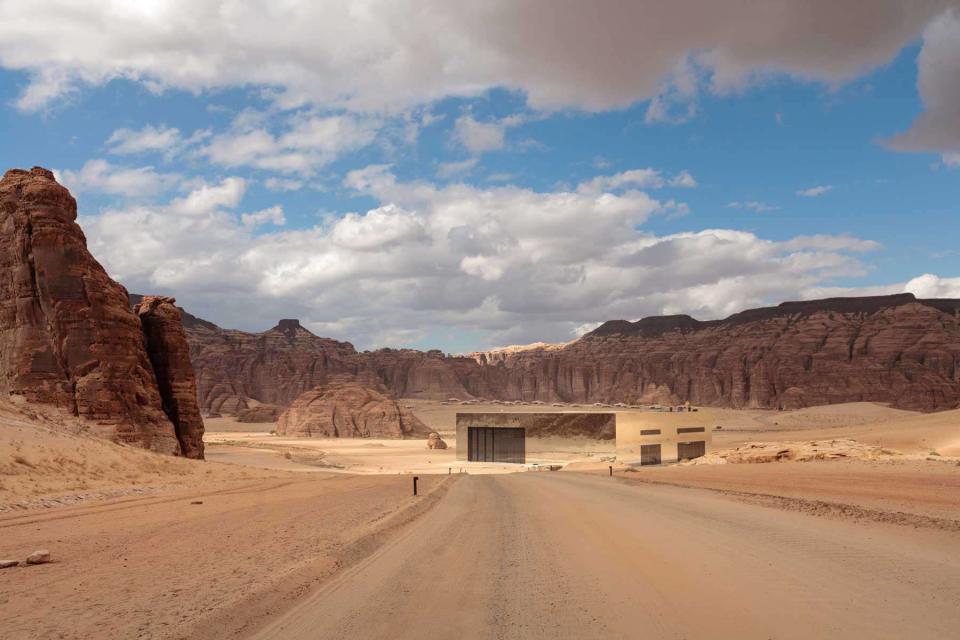
Kevin West
Maraya, a new performing arts center in AlUla, is the world’s largest mirrored building.It started with a roadblock. Our caravan of three SUVs and one dented pickup truck was rushing toward a windswept valley near AlUla (pronounced all-oo-la), an oasis in northwestern Saudi Arabia. I’d been at an archaeological site with my two full-time guides and a bevy of other handlers and officials from the Royal Commission for AlUla, or RCU, the agency in charge of development in this remote sector of Saudi’s Medina province; now we were heading to lunch at Banyan Tree AlUla, a new resort hotel. But before we reached the freshly paved two-lane road, a policeman waved us over. No traffic allowed, we were told. A high dignitary was coming. The crew at once reached for their social media feeds. Was it MBS? An electric charge ran the length of the caravan. Who else could block traffic? MBS!
Mohamed bin Salman, Saudi Arabia’s crown prince and de facto ruler, is said to camp, Bedouin-style, in the nearby mountains, where wolves roam and ancient petroglyphs record an Arabian bestiary of ostriches and ibex. Yes, it could be MBS. We waited. In a kingdom, everyone awaits the king — or, in this case, the internationally notorious king-in-waiting.
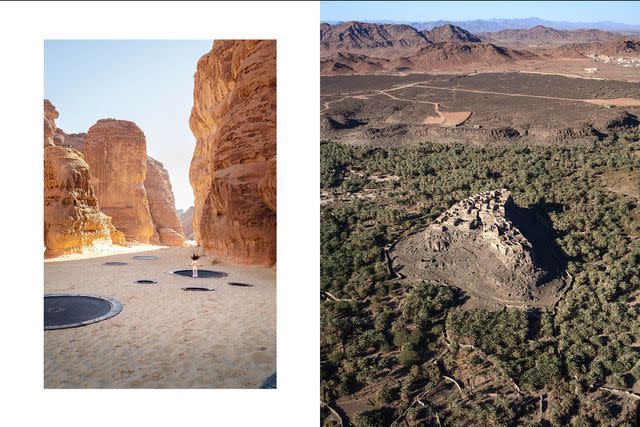
Kevin West
From left: Saudi artist Manal Aldowayan’s Now You See Me, Now You Don’t, a series of trampolines, was commissioned for the 2020 edition of Desert X AlUla; the oasis of Khaybar, as seen on a helicopter flight from AlUla.Back in the dented pickup the young driver, Ibrahim Al-Fatouh, and I made small talk using Google Translate. Ibrahim works at Dadan, the ancient city we’d just visited, and was driving me only because an official unexpectedly joined our group, leaving us one SUV seat short. The rest of the crew, the regulars, had been detailed to my trip by the RCU — the government entity with $15 billion to spend on building a luxury destination for foreign tourists.
Since its inception in 2017, the RCU has constructed a new international airport, laid roads across the desert, funded major archaeological digs, recruited luxury-hotel operators including Aman Resorts, launched a local-food economy, bred endangered Arabian leopards to be reintroduced to the wild, put up the world’s largest mirrored building, hosted an exhibition of site-specific contemporary sculpture, drawn up plans for a major museum, announced a 13.7-mile electric tramway, and, least but not last, flown in reporters like me to witness the giant scale of their undertaking.
Early people came to AlUla for the source of life: water. Trails linking the oases of western Arabia became travel routes for nomads, tribes, warriors, herders, settlers, traders, and, millennia later, pilgrims on the way to Mecca.
We waited. Inspiration grabbed Al-Fatouh and he typed something into his phone. As he handed it over, high-octane EDM played over a video of a pickup truck rally across an ocean of desert sand. Each truck was a vintage gem, a perfectly restored, apple-red American pickup from the 1970s, and
each driver looked very happy beneath his red-checked shemagh, or headscarf, flapping in his open window. My Tennessee uncles drove such trucks when I was a kid, and I coveted them. Seeing them restored to glory in Saudi Arabia swelled my American pride. I gave Al-Fatouh an enthusiastic thumbs-up.
Just then the awaited dignitary passed: not MBS, after all, but an American diplomat. Our caravan sped on to the soon-to-be-completed Banyan Tree. After lunch and a tour — the property, which opened in October, consists of safari-style tents in a dramatic desert valley — I was escorted back outside for a sunset visit to the Nabataean tomb complex at Hegra. Formerly known as Mada’in Salih and all but inaccessible to visitors, the site spreads across an empty desert valley dotted with 111 tombs carved into solid rock. It was built as the final resting place for grandees of the Nabataean kingdoms, known for their northern capital, Petra, in what is now Jordan. Dominant in the region 2,000 years ago, the Nabataeans and two other ancient societies, the Dadanites and the Liyhanites, left a rich archaeological record in AlUla, a region the size of Massachusetts containing more than 30,000 individual sites. Hegra, the crown jewel, became Saudi Arabia’s first UNESCO World Heritage site in 2008.
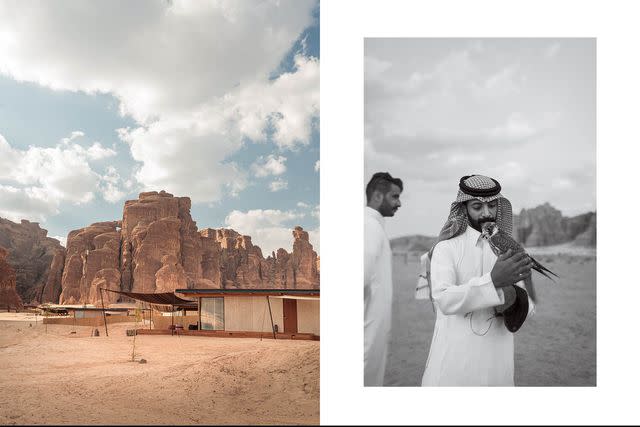
Kevin West
From left: A guest villa at Habitas AlUla, the first resort to open in the region; local guides with a falcon near the Hegra complex.What met me outside the hotel — my personal conveyance to Hegra — was not the tinted-window SUV I had been expecting but an apple-red 1979 GMC Sierra 2500 pickup driven by a mustachioed man in a red shemagh. Its six-cylinder engine rumbled like a lion in the Serengeti; its muffler spewed a mechanic’s cologne of imperfectly combusted gasoline. “We know that you like vintage,” purred Maarouf Dawalibi, CEO of the Traveling Panther, the tour operator hired by the RCU to arrange my trip. “We thought you might like this.” I was floored.
Windows open to the red-rock landscape, classical Arabic music blasting from the tricked-out sound system, the GMC roared into Hegra at golden hour. The entire valley seemed empty. Not a soul at Jabal Banat, a complex of women’s tombs carved into a red boulder the size of a ship. Not a car on the gravel road to the Tomb of Lihyan, Son of Kuza — the largest tomb in Hegra. (By way of comparison, Petra sees 1 million visitors a year.) I sprinted the last quarter-mile across empty dunes, half drunk on oxygen and adrenaline, to stand alone as the shadow of the valley’s rim spread over the tomb, also known as Qasr Al-Farīd, or “the lonely castle” — my own private sunset.
Saudi Arabia’s intangible heritage is rich. Music sounded everywhere I went, and references to poetry, song, and scripture sprinkled many conversations.
In the day’s afterglow, I headed back to the pickup. The big engine idled as the driver sat behind the wheel — wasting gas apparently being no sin in this kingdom built on hydrocarbon. He was chatting with a young guide, Sulaiman Aljuwayhil, who told me that the driver’s father had been born in this very valley. His Bedouin family drew water from Nabataean wells until the community was relocated to make way for tourism.
The driver’s father had owned an identical truck — same make, model, and year — as did, by coincidence, Aljuwayhil’s father. “My dream was to grow up and have this one,” he continued, a sentiment I could relate to. “The sound is like music in my ear.”
As the rose-gold sky turned dusky blue, I caught sight of the man responsible for this moment. Not just the human moment of gasoline-scented nostalgia, but also the grand historical moment: the opening of a conservative religious kingdom to foreign visitors, the economic pivot away from oil to renewable energy and high tech, the unrolling of broad social reforms, and the careful easing of certain Islamic rigidities. Dangling from the rearview mirror, in the place my uncles would have hung a pine-tree air freshener, was an official portrait of MBS.
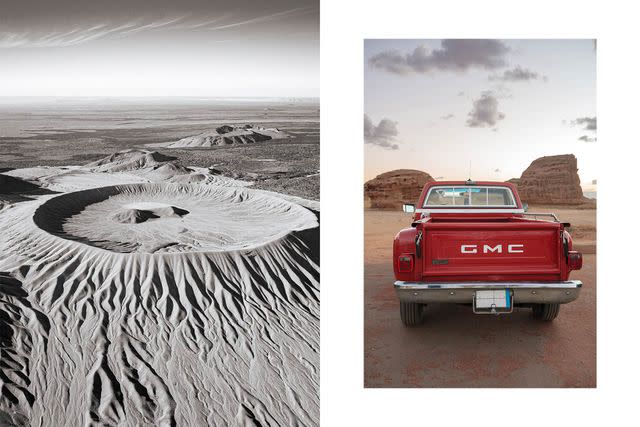
Kevin West
From left: Jabal Abyad, known as the white volcano; reconditioned 1970s trucks are used to transport guests in AlUla.MBS was behind everything I saw. As grandson of Ibn Saud, who unified Saudi Arabia in 1932 and ruled as its first king until his death in 1953, MBS has the power and the immense resources to reshape the kingdom according to his wishes. His blueprint for the future is called Vision 2030, and it commits to, among many other goals, making Saudi Arabia a must-visit destination for travelers from around the world.
Before my trip late last year, my personal mental wiki page for Saudi Arabia included sand dunes, oil wells, the Grand Mosque in Mecca, and women covered up under the black abaya (cloak), hijab (head covering), and niqab (veil). It had never crossed my mind to visit — not, at least, until word got out about Hegra. Hardly known to foreigners and largely inaccessible, Hegra was thrown open to international tourism in 2019, when Saudi Arabia issued its first tourist visas and declared the region the kingdom’s premier culture and heritage destination. I was aware of the regime’s history of brutality toward journalists and the LGBTQ community, as well as the limits it imposed on women and the comparatively trivial ban on alcohol. Still, I wanted to go — first to challenge my own preconceptions and, second, to see Hegra before the crowds arrived.
When I think back over my visit, what I remember most vividly are not the ancient monuments I saw but the young people I met. There was Amal Alijuhani, a bilingual rāwī, or guide, at Jabal Ikmah, known as the “open library” for the archive of inscriptions carved into the canyon’s sandstone walls. Alijuhani grew up in AlUla and wore the most conservative garb: only her eyes were visible. But she topped her hijab with an embroidered Yankees cap and drove a 2021 Dodge Charger, a badass American muscle car.
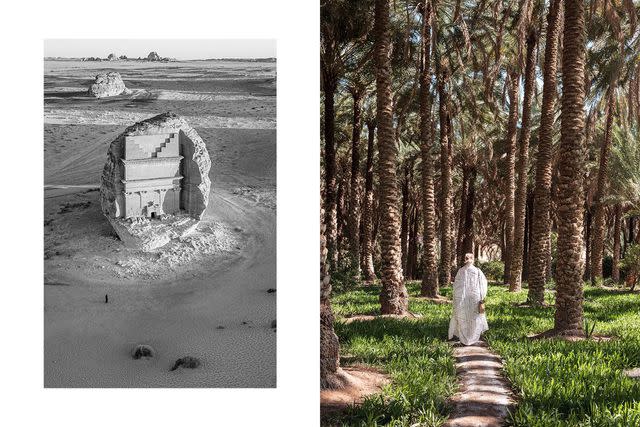
Kevin West
From left: The Tomb of Lihyan, son of Kuza, in Saudi Arabia’s AlUla region, is thought to be 2,000 years old; Laura Alho, creator of Blue Abaya, a blog for expats living in Saudi Arabia, in the oasis outside AlUla’s Old Town.There was Aljuwayhil, born in Riyadh and familiar with America from childhood trips taken to undergo complex surgeries and, more recently, state-sponsored trips for his rāwī training. Suleiman lacked only the time, not the breath or memory, to recount AlUla’s entire history, which he interspersed with recitations of classical Arabic poetry. For him, the job of rāwī was the start of a career, the discovery of a vocation, a livelihood, and a life.
There was Huda Al Osaimi of the Traveling Panther, my chief guide/translator/explainer/fixer. She was all charm, except when bossing around a surly official or checkpoint guard. During our many hours together, she tactfully explained the social reforms unrolled by MBS at the time of his elevation to crown prince in 2017. Women were no longer required to cover themselves in public, although many — even some in their teens and 20s — continue to do so. Women also can drive now, apply for a passport, travel without a male guardian, and live alone. “The changes happened so fast, we didn’t understand how important they were,” she said.
And then there was shy Yazeed Al Anazi, my elegant all-hours driver, who knew more English than he let on, most of it learned from watching YouTube. Once when I asked about the taste of camel, a local delicacy, he announced, “We are going!” and drove me straight to his favorite mom-and-pop restaurant, where he absolutely refused to let me pay for my meal of camel stew over rice. (For the record, it tastes a lot like mutton.)
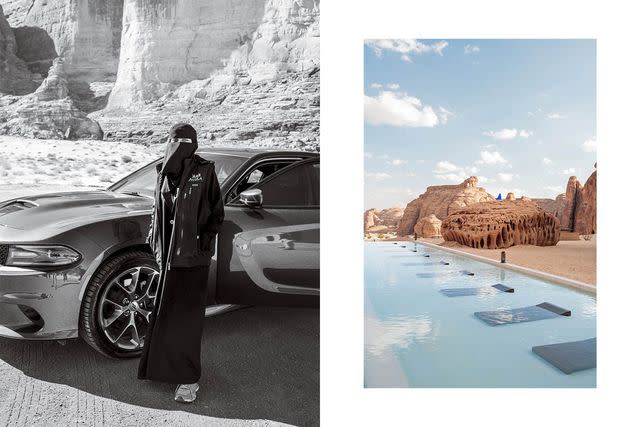
Kevin West
From left: Amal Aljuhani, a guide at Jabal Ikmah, with her Dodge Charger; the pool at Habitas, which is open to swimmers of all genders.Saudi Arabia is a kingdom of youth. Nearly 70 percent of Saudis are younger than 35, and 50 percent are under 25. Digital natives, they are familiar with American popular culture to an extent we cannot imagine in reverse. (Quick: name one actor or singer from Saudi Arabia.) Their view of tomorrow sits somewhere between yallah (let’s go!) and inshallah (God willing), a useful if equivocal expression meaning either a confident “certainly” or a politely ambiguous “we’ll see.” MBS, 32 when he became crown prince, is their leader and represents the ascendancy of their generation. The social reforms and tolerance for movies and dance music benefit the young (MDLBeast Soundstorm, an electronic music festival first staged in Riyadh in 2020, last year attracted a crowd of 700,000 over four days). They are certainly beneficiaries of Vision 2030’s grand scheme to leverage gigantic sums drawn from the kingdom’s oil trade to build a diversified, industrial economy.
Before Vision 2030, travel to Saudi was restricted almost entirely to business or to the hajj, the holy pilgrimage to Mecca. Now it’s seen as a hot growth sector. Because AlUla was chosen to be the country’s first “hospitality oasis,” the proof of concept, it can’t fail. The destination will establish best practices for future developments throughout the kingdom’s 13 administrative regions, which cover a landmass the size of Greenland. “Saudi Arabia is a continent in itself,” as one official I spoke to put it.
Related: The 10 Best Cities in North Africa and the Middle East
The businesses I saw on my trip are in many ways mere placeholders, promises to be fulfilled. They underscore just how much work it will take to realize MBS’s twofold ambition for tourism — to stimulate the local job market with foreign dollars and to burnish the kingdom’s reputation abroad. For example, the RCU envisions Old Town AlUla and Aljadida, the adjacent new town, as a tourist district with boutique hotels, restaurants, shops, and eateries. For now, Old Town is little more than a group of tumbledown mud-brick buildings.
“Vision 2030 is using tourism and heritage as a way to empower local people economically,” explained RCU heritage preservation and restoration advisor Andrew Hall over lunch. When it comes to staffing, the RCU is taking a distinctly modern approach. Half of AlUla’s 30 rāwī are local women. Until recently, women were not allowed to work behind a hotel reception desk; now female receptionists are commonplace. “Five years ago tourism was frowned upon,” said Antony Treston, an Englishman who worked throughout the Middle East before becoming Banyan Tree’s general manager two years ago. “The education and enthusiasm for tourism among the local community is amazing.”
When I think back over my visit, what I remember most vividly are not the ancient monuments I saw but the young people I met.
I discovered as much for myself when I met Turki Alamri at Habitas, my hotel in a dramatic box canyon near Banyan Tree. Alamri, who told me he came from Jeddah, a developed, relatively cosmopolitan port city on the Red Sea, shuttles guests around the sprawling property in an electric golf cart. Equal parts hairstyle, YouTube English, and pluck, the Gen-Z dynamo swooped in on me my first day as I walked off my jet lag. He toured me around as if he were my personal host, showing off the infinity pool, the spa compound, and the site-specific sculptures tucked into the landscape as part of Desert X AlUla, a world-class contemporary art biennale co-curated by the English writer Neville Wakefield.
“Anything you need, you push zero, ask for Turki,” he said as he dropped me back at my bungalow, a promise kept no matter what hour I called the front desk. “I show you everything.”
More Trip Ideas: The 10 Best City Hotels in North Africa and the Middle East
How old is AlUla? How far back do you want to go? Stone Age tools found in the area date from 200,000 years ago. From the air I saw prehistoric stone monuments, called mustatils, built some 7,000 years ago by pastoralists who grazed cattle across what was then a wetter, greener Arabian Peninsula. Another day, my jeep trek through the 580-square-mile Sharaan Nature Reserve led to a 7,000-year-old petroglyph of a camel nursing her calf. AlUla’s early written history was pecked into the water-smoothed walls of a slot canyon above Ashar Valley, where Aljuwayhil pointed out phrases of Dadanic script — one of 10 ancient languages recorded in the region — and read bits of Arabic from more recent centuries, mostly traveler’s graffiti of the faisal was here variety. “Today we have invented Snapchat,” he mused, “but since the dawn of time people have documented their experience.”
Early people came to AlUla for the source of life: water. Trails linking the oases of western Arabia became travel routes for nomads, tribes, warriors, herders, settlers, traders, and, millennia later, pilgrims on the way to Mecca. Water also created the conditions for agriculture and settled civilizations. As many as 60 springs throughout the area made it possible to grow grains from the Fertile Crescent, figs from the Mediterranean, citrus fruits from Asia, fragrant roses from Damascus, and native date palms.
“We have to preserve this oasis as an example of traditional agriculture in the Arabian Peninsula,” said James Thompson, the RCU’s agricultural-sector manager, as we walked through a farm carpeted with fragrant Medina mint and shaded by date palms, their trunks as thick as temple columns.
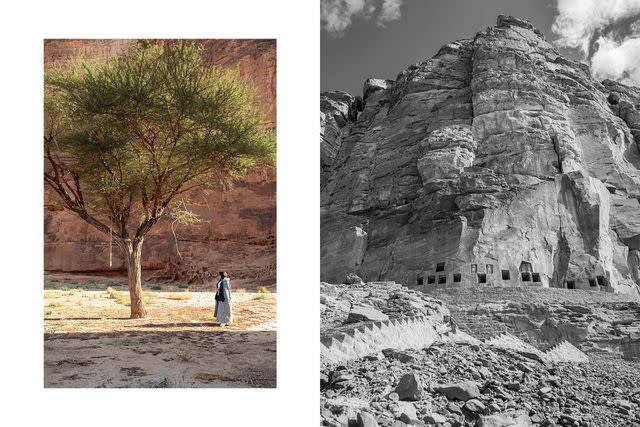
Kevin West
From left: Huda Al Osaimi of the Traveling Panther, a tour operator, in AlUla’s Sharaan Nature Reserve; the Lion Tombs at Dadan, near Hegra.The oasis farms we visited once reached the walls of Old Town, although a modern roadway separates them today. (It will eventually be removed, I was told.) Built in the 12th century, Old Town’s mud-brick buildings had remained unchanged until the 1970s, when the government provided land and no-interest loans for citizens to build their own houses with electricity, water, and plumbing in what became the new town. Within a few years, the wooden roof beams of Old Town were attacked by termites and winter rains degraded the adobe walls.
Vision 2030 wants to reverse the damage and modernize Old Town. On a hard-hat tour with Hall, the vast ruins looked beyond hope, but anything is possible with enough money; after all, Hall reminded me, these houses, bakeries, and squares were occupied within living memory. The investment to rebuild will be immense, of course, but the timeline for returns is decades long. MBS could plausibly be in charge for the next 50 years. “You create something that creates an economy around it,” Hall explained.
Saudi Arabia is a kingdom of youth. Nearly 70 percent of Saudis are younger than 35, and 50 percent are under 25. Digital natives, they are familiar with American popular culture to an extent we cannot imagine in reverse.
It occurred to me on my tour that AlUla’s material culture is a simple one, compared with that of, say, Marrakesh or Istanbul. Instead of interiors with dazzling mosaics, I saw unadorned mud-brick buildings, simple crafts, and plain textiles. But Saudi Arabia’s intangible heritage is rich. Music sounded everywhere I went, and references to poetry, song, and scripture sprinkled many conversations. Eloquent sermons echoed from loudspeakers during Friday prayers, and the elaborate shows of hospitality — the endless cups of tea and bowls
of dates — spoke to a highly formalized social culture.
More Trip Ideas: A Trip Through Oman
The literal meaning of rāwī is “reciter,” someone who remembers stories, and the role had its origins in pre-Islamic poetry. It was the rāwī who retold the sayings of Muhammad before the Koran was widely available in written form. The Saudis I met told me their own stories about Arabia’s past, and I was reminded of the way history shifts like desert sands.
On my way to AlUla I had a layover day in Riyadh and visited the King Abdulaziz Historical Center. A tour guide sped me through plain galleries of natural history specimens and pre-Islamic artifacts. Upstairs, we lingered in front of magnificent displays dedicated to the life of Muhammad, the spread of Islam, and the unification of the kingdom under Ibn Saud, known to Saudis as King Abdulaziz.
This official narrative, shaped by a pre-MBS generation of leadership, amounts to soft propaganda about the legitimacy of the Saud dynasty as the first and only rulers of a religious kingdom united under the Islamic faith. By contrast, my experiences in AlUla — Hegra, the Open Library, the mustatils, the rāwī — created a collage of a complex past: many rulers, many faiths.
As the RCU floods AlUla with money, it is buying up enough talent and manpower to ram through epochal changes before Vision 2030 hits its stated deadline. The immense spending makes possible I-can’t-believe-my-eyes grand gestures such as Maraya, a performance hall and rooftop restaurant contained within the world’s largest mirrored building. The architectural spectacle will surely light up a million — 10 million — social media feeds. It seems to float above the red-rock landscape like a computer simulation, a geometric model of pure form, its glinting surface wrapped around an inner mystery. Or maybe around an empty core.
The RCU has made small-bore investments, too, such as funding Madrasat Addeera, an unshowy craft school housed in a former girls’ academy. “For us, this place, this landscape, is mesmerizing,” said English expat Harriet Stiles, design and program manager for Turquoise Mountain, one of the charities that support the school. “But if you live here your whole life, it’s familiar.” Students learn to value their Saudi heritage, applying traditional techniques to new forms, such as weaving fashionable handbags from palm fronds. Their creations sell to tourists on the Incense Road, a shopping thoroughfare in the Old Town. Most of the artisans are women.
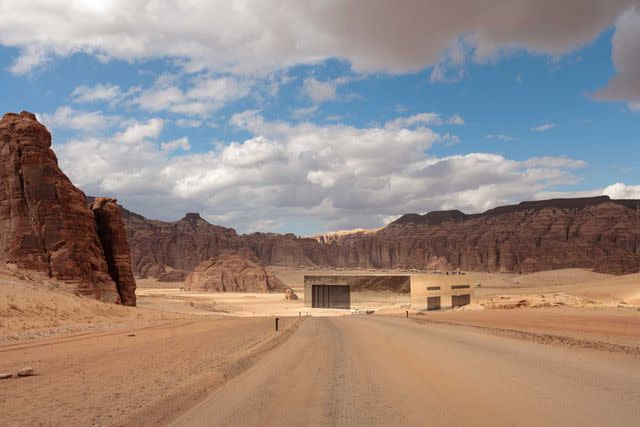
Kevin West
Maraya, a new performing arts center in AlUla, is the world’s largest mirrored building.I couldn’t help being impressed by the scope of the undertaking and the earnest, cheerful sense of purpose shown by the foreign consultants. (Of course, their cheer is well compensated.) During an excursion to a farm owned by Princess Noura Aladel, I chatted with Sumantro Ghose, RCU’s artistic programming director. He helped develop Desert X and oversees some of the art exhibitions at Maraya, both of which champion the work of Saudi artists. Ghose, who is British, describes his work as “pre-activation of cultural assets,” meaning he sifts the past for seeds of cultural programming, such as a current project on scent that will celebrate the historic incense trade. AlUla was once a crossroads of civilizations, he reminded me. Why can’t it be again?
“You see how AlUla fits into the Saudi national vision of opening the country as a center of learning,” Ghose explained as we tasted rose-petal jam and citron preserves made in Princess Noura’s kitchens. “If you look at Hegra, you can see artisans were working here. We want to reopen that. The belief in the power of culture is genuine.”
Related: Saudi Arabia Is Planning A Car-Free City
There are self-evident reasons to make AlUla the pilot site for a new tourism industry—cultural heritage, scenic beauty, all that. But perhaps it’s no accident that this remote corner of the kingdom lies far from Ridayh, the heartland of Islamic fundamentalism. Would the holy cities of Mecca and Medina ever allow mixed-gender pools, a standard amenity in AlUla? Even in AlUla, where hospitality workers turn a blind eye, how far will social tolerance stretch?
I asked many people if gay and unmarried couples could comfortably visit. Guests will be welcomed, I was repeatedly told by Saudis and expats alike, if they respect conservative social mores. Islam demands it. When I expressed skepticism, I was reminded that the push to welcome tourists comes from the very top.
Saudi Arabia is a country on the cusp, not what it was 20 years ago, 10 years ago, five years ago. Talking to MBS’s young subjects, I sensed optimism, possibility, momentum. I thought of China in the early 2000s and Spain after Franco — moments when restrictive societies shifted after once-in-a-lifetime political change. During my lunch at Old Town’s Suhail restaurant with Hall, he remembered living through another such moment. The end of apartheid in South Africa, he said, was a time when you could make things work. “You were forgiven for experimenting,” he explained, and normally rigid bureaucracies temporarily loosened up.
“I sense a similar thing here,” he continued as he dished out stuffed grape leaves and chicken saleeq al taif. “It’s a window of opportunity.”
The kingdom is not a Western democracy; the world has witnessed MBS transgressing international norms. Yet for all that, it is impossible not to wish the best for the young people of AlUla. For their sake, may the vision of a more open Saudi be realized. Inshallah.
How to Do AlUla
Where to Stay
Banyan Tree: Thirty minutes from Old Town, this resort evokes the design of a Bedouin desert camp, with 79 luxurious tented villas clustered at the edge of the vast Ashar Valley.
Habitas: Luxury wooden villas tucked into a dramatic red sandstone canyon 20 minutes from the unesco World Heritage site of Hegra. The open-air restaurant and mixed-gender infinity pool have desert views; the brand has also opened Caravan by Habitas, where guests can stay in Airstream trailers.
Where to Eat
Suhail: Set in a restored mud-brick house in Old Town, this restaurant serves updated Arabic dishes, including saleeq al taif (roasted chicken over milk-cooked rice with green and red chili sauces), alongside national favorites like kbab miro hijazi (camel and lamb meatballs).
What to Do
Dadan: A small but still impressive tomb complex from the Dadanite kingdom that’s etched into soaring cliffs at the edge of the oasis that runs from Old Town to Hegra. Work is under way to excavate the ruined city nearby.
Hegra: The crown jewel of Saudi Arabia’s archaeological sites, where 111 tombs were carved into cliffs and ship-size boulders by the Nabataeans 2,000 years ago. Located in an empty, windswept valley, it’s worth making visits at both dawn and sunset.
Jabal Ikmah: Also known as the Open Library, the walls of this narrow canyon 10 minutes outside of Old Town hold hundreds of pre-Islamic inscriptions in at least four ancient languages.
Maraya: Because of its mirrored façade, this huge performance hall seems to levitate above the desert. The venue spotlights both Arabic and Western musical acts. Maraya Social, the flashy rooftop restaurant, cultivates the VIP vibes of a Miami or Hollywood hot spot.
Sharaan Nature Reserve: Scarce and secretive desert wildlife is rarely seen, but look for tracks left by Arabian wolves, mountain gazelles, Nubian ibex, and red-necked ostriches in this 580-square-mile wilderness preserve.
How to Book
Experience AlUla: The website of the Royal Commission for AlUla provides comprehensive information and booking services, including flights, lodging, dining, sightseeing, and other resources.
The Traveling Panther: Founded by Saudi princesses, this luxury tour company provides full-service trip planning, custom itineraries, and on-the-ground support for international visitors. A five-day itinerary similar to the one in the story — excluding the helicopter tour
of Khaybar — costs approximately $12,000 per person.
Getting There
One-year, multiple-entry tourist e-visas are available for $80 at visa.visitsaudi.com. Flights from the U.S. to AlUla on the kingdom’s national carrier, Saudia, connect through Riyadh; additional carriers, including Emirates, offer service to Riyadh, connecting through Dubai. Stay at the Four Seasons at Kingdom Centre before catching a short evening flight
to AlUla.
A version of this story first appeared in the December 2022/January 2023 issue of Travel + Leisure under the headline "Treasures of Arabia."
For more Travel & Leisure news, make sure to sign up for our newsletter!
Read the original article on Travel & Leisure.


